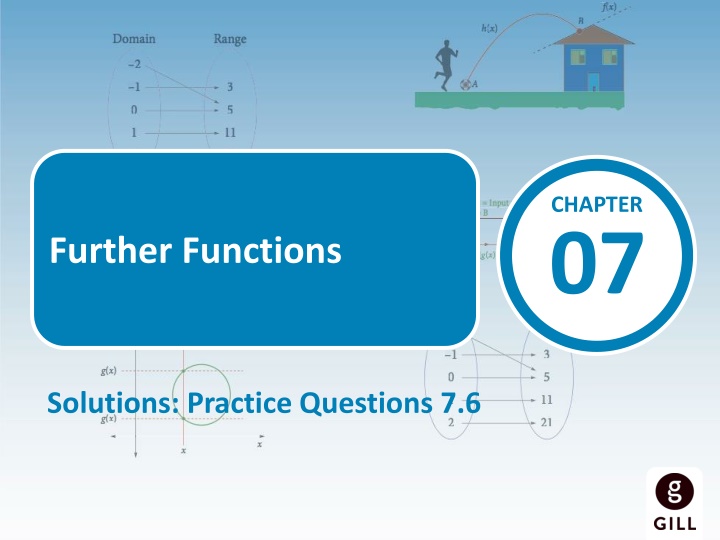
Pair of Functions Output Calculations
Discover the outputs at point B for various inputs at point A in a pair of functions scenario. Understand how the input of the first function becomes the input of the second function, leading to specific outputs. Practice questions and solutions provided for a better grasp of function interactions.
Download Presentation

Please find below an Image/Link to download the presentation.
The content on the website is provided AS IS for your information and personal use only. It may not be sold, licensed, or shared on other websites without obtaining consent from the author. If you encounter any issues during the download, it is possible that the publisher has removed the file from their server.
You are allowed to download the files provided on this website for personal or commercial use, subject to the condition that they are used lawfully. All files are the property of their respective owners.
The content on the website is provided AS IS for your information and personal use only. It may not be sold, licensed, or shared on other websites without obtaining consent from the author.
E N D
Presentation Transcript
CHAPTER 07 Further Functions Solutions: Practice Questions 7.6
07 Practice Questions 7.6 1. The diagram shows a pair of functions, whereby the output of the first function f, becomes the input of the second function, g. Find the outputs at point B for the following inputs at A: 1 (i) Substitute 1 in as the input, A, in the first function: 3(1) + 4 = 7 Now, substitute the output of 7 in as the input into the second function: (7)2 5 = 44 Therefore, an input of 1 at A results in an output of 44 at B.
07 Practice Questions 7.6 1. The diagram shows a pair of functions, whereby the output of the first function f, becomes the input of the second function, g. Find the outputs at point B for the following inputs at A: 3 (ii) Substitute 3 in as the input, A, in the first function: 3(3) + 4 = 13 Now, substitute the output of 13 in as the input into the second function: (13)2 5 = 164 Therefore, an input of 3 at A results in an output of 164 at B.
07 Practice Questions 7.6 1. The diagram shows a pair of functions, whereby the output of the first function f, becomes the input of the second function, g. Find the outputs at point B for the following inputs at A: 0 (iii) Substitute 0 in as the input, A, in the first function: 3(0) + 4 = 4 Now, substitute the output of 4 in as the input into the second function: (4)2 5 = 11 Therefore, an input of 0 at A results in an output of 11 at B.
07 Practice Questions 7.6 1. The diagram shows a pair of functions, whereby the output of the first function f, becomes the input of the second function, g. Find the outputs at point B for the following inputs at A: 2 (iv) Substitute 2 in as the input, A, in the first function: 3( 2) + 4 = 2 Now, substitute the output of 2 in as the input into the second function: ( 2)2 5 = 1 Therefore, an input of 2 at A results in an output of 1 at B.
07 Practice Questions 7.6 1. The diagram shows a pair of functions, whereby the output of the first function f, becomes the input of the second function, g. Find the outputs at point B for the following inputs at A: 5 (v) Substitute 5 in as the input, A, in the first function: 3( 5) + 4 = 11 Now, substitute the output of 11 in as the input into the second function: ( 11)2 5 = 116 Therefore, an input of 5 at A results in an output of 116 at B.
07 Practice Questions 7.6 2. f (x) = 2x + 1 and g(x) = 5 x are two functions, where x . Find: f (2) (i) f (x) = 2x + 1 f (2) = 2(2) + 1 = 5
07 Practice Questions 7.6 2. f (x) = 2x + 1 and g(x) = 5 x are two functions, where x . Find: g ( 1) (ii) g(x) = 5 x g( 1) = 5 ( 1) = 5 + 1 = 6
07 Practice Questions 7.6 2. f (x) = 2x + 1 and g(x) = 5 x are two functions, where x . Find: f g ( 1) (iii) From part (ii), g ( 1) = 6 f g ( 1) = f (6) = 2(6) + 1 = 12 + 1 = 13
07 Practice Questions 7.6 2. f (x) = 2x + 1 and g(x) = 5 x are two functions, where x . Find: (g f )(2) (iv) From part (i), f (2) = 5 g f (2) = g(5) = 5 5 = 0
07 Practice Questions 7.6 2. f (x) = 2x + 1 and g(x) = 5 x are two functions, where x . Find: g ( f (x)) (v) g( f (x)) = g(2x + 1) = 5 (2x + 1) = 5 2x 1 = 4 2x
07 Practice Questions 7.6 2. f (x) = 2x + 1 and g(x) = 5 x are two functions, where x . Find: ( f g)( 3) (vi) First we must find the value of g( 3): g( 3) = 5 ( 3) = 5 + 3 = 8 ( f g)( 3) = f(8) = 2(8) + 1 = 17
07 Practice Questions 7.6 2. f (x) = 2x + 1 and g(x) = 5 x are two functions, where x . Find: (vii) g2(5) g2(5) = g g(5) First we must find the value of g(5): g(5) = 5 5 = 0 g2(5) = g(0) = 5 0 = 5
07 Practice Questions 7.6 2. f (x) = 2x + 1 and g(x) = 5 x are two functions, where x . Find: (viii) f 2(x) f 2(x) = f(x) f(x) = f(2x + 1) = 2(2x + 1) + 1 = 4x + 2 + 1 = 4x + 3
07 Practice Questions 7.6 3. p(x) = x2 4 and q(x) = 7x + 1 are two functions, where x . Find: p( 3) (i) p(x) = x2 4 p( 3) = ( 3)2 4 = 9 4 = 5
07 Practice Questions 7.6 3. p(x) = x2 4 and q(x) = 7x + 1 are two functions, where x . Find: q(5) (ii) q(x) = 7x + 1 q(5) = 7(5) + 1 = 35 + 1 = 36
07 Practice Questions 7.6 3. p(x) = x2 4 and q(x) = 7x + 1 are two functions, where x . Find: q p(0) (iii) First we must find the value of p(0) p(0) = (0)2 4 = 0 4 = 4 q p(0) = q( 4) = 7( 4) + 1 = 28 + 1 = 27
07 Practice Questions 7.6 3. p(x) = x2 4 and q(x) = 7x + 1 are two functions, where x . Find: (p q)( 1) (iv) First we need to find the value of q( 1) q( 1) = 7( 1) + 1 = 7 + 1 = 6 (p q)( 1) = p( 6) = ( 6)2 4 = 36 4 = 32
07 Practice Questions 7.6 3. p(x) = x2 4 and q(x) = 7x + 1 are two functions, where x . Find: (q p)( 2) (v) First we need to find the value of p( 2) p( 2) = ( 2)2 4 = 4 4 = 0 (q p)( 2) = q(0) = 7(0) + 1 = 1
07 Practice Questions 7.6 3. p(x) = x2 4 and q(x) = 7x + 1 are two functions, where x . Find: q2( 2) (vi) q2( 2) = q q( 2) First we need to find the value of q( 2) q( 2) = 7( 2) + 1 = 14 + 1 = 13 q q( 2) = q( 13) = 7( 13) + 1 = 90
07 Practice Questions 7.6 3. p(x) = x2 4 and q(x) = 7x + 1 are two functions, where x . Find: (vii) q (p (x)) = q(x2 4) = 7(x2 4) + 1 = 7x2 28 + 1 = 7x2 27
07 Practice Questions 7.6 3. p(x) = x2 4 and q(x) = 7x + 1 are two functions, where x . Find: (viii) p2(x) = p p(x) = p(x2 4) = (x2 4)2 4 = (x2 4)(x2 4) 4 = x4 8x2 + 16 4 = x4 8x2 + 12
07 Practice Questions 7.6 4. The diagram shows the graphs of two functions, f(x) and g(x). Use the graph to find the value of the following: f (1) (i) When x = 1, y = 3 for the f function f (1) = 3
07 Practice Questions 7.6 4. The diagram shows the graphs of two functions, f(x) and g(x). Use the graph to find the value of the following: g( 3) (ii) When x= 3, y= 1 for the g function g( 3) = 1
07 Practice Questions 7.6 4. The diagram shows the graphs of two functions, f(x) and g(x). Use the graph to find the value of the following: f (g( 3)) (iii) g( 3) = 1, from part (ii) fg( 3) = f( 1) = 5
07 Practice Questions 7.6 4. The diagram shows the graphs of two functions, f(x) and g(x). Use the graph to find the value of the following: (g f )(1) (iv) f (1) = 3 from part (i) (g f )(1) = g(3) = 0
07 Practice Questions 7.6 4. The diagram shows the graphs of two functions, f(x) and g(x). Use the graph to find the value of the following: g f ( 4) (v) First find f ( 4) = 1, from the graph gf ( 4) = g(1) = 3
07 Practice Questions 7.6 4. The diagram shows the graphs of two functions, f(x) and g(x). Use the graph to find the value of the following: ( f g )(0) (vi) First find g (0) = 0, from the graph f g(0) = f(0) = 2
07 Practice Questions 7.6 4. The diagram shows the graphs of two functions, f(x) and g(x). Use the graph to find the value of the following: (vii) g[g (1)] First find g (1) = 3, from the graph gg(1) = g( 3) = 1
07 Practice Questions 7.6 4. The diagram shows the graphs of two functions, f(x) and g(x). Use the graph to find the value of the following: (viii) f 2( 2) f 2( 2) = f f( 2) First find f ( 2) = 2, from the graph f f( 2) = f(2) = 1
07 Practice Questions 7.6 5. The diagram shows the graphs of two functions, g(x) and h(x). Use the graph to find the value of the following: h( 1) (i) When x= 1, y = 1 for the h function h( 1) = 1
07 Practice Questions 7.6 5. The diagram shows the graphs of two functions, g(x) and h(x). Use the graph to find the value of the following: g(0) (ii) When x = 0, y = 3 for the g function g(0) = 3
07 Practice Questions 7.6 5. The diagram shows the graphs of two functions, g(x) and h(x). Use the graph to find the value of the following: g(h( 3)) (iii) First find h( 3) = 4, from the graph g(h( 3)) = g(4) = 0
07 Practice Questions 7.6 5. The diagram shows the graphs of two functions, g(x) and h(x). Use the graph to find the value of the following: (h g)( 1) (iv) First find g( 1) = 1, from the graph (h g)( 1) = h(1) = 5
07 Practice Questions 7.6 5. The diagram shows the graphs of two functions, g(x) and h(x). Use the graph to find the value of the following: h(h( 4)) (v) First find h( 4) = 1, from the graph h(h( 4)) = h(1) = 5
07 Practice Questions 7.6 5. The diagram shows the graphs of two functions, g(x) and h(x). Use the graph to find the value of the following: (g h)(2) (vi) First find h(2) = 1, from the graph (g h)(2) = g( 1) = 1
07 Practice Questions 7.6 5. The diagram shows the graphs of two functions, g(x) and h(x). Use the graph to find the value of the following: (vii) hg( 4) First find g( 4) = 0, from the graph hg( 4) = h(0) = 2
07 Practice Questions 7.6 5. The diagram shows the graphs of two functions, g(x) and h(x). Use the graph to find the value of the following: (viii) g2( 2) g2( 2) = (g g)( 2) First find g( 2) = 0, from the graph (g g)( 2) = g(0) = 3
07 Practice Questions 7.6 6. The diagram shows the graphs of two functions, g (x) and f (x). Use the graph to find the value of the following: g(0) (i) g(0) = 5 f ( 1) (ii) f ( 1) = 3 g (f ( 1)) (iii) = g ( 3) not possible to find. Off the scale.
07 Practice Questions 7.6 6. The diagram shows the graphs of two functions, g (x) and f (x). Use the graph to find the value of the following: ( f g )(3) (iv) f (2 5) = 6 8 g (g (3)) (v) g (2 5) = 5 5 ( g f )(4) (vi) g(3 1) = 2
07 Practice Questions 7.6 6. The diagram shows the graphs of two functions, g (x) and f (x). Use the graph to find the value of the following: (vii) f g ( 2) f (1) = 6 4 (viii) f 2(0) f (3 2) = 6
07 Practice Questions 7.6 7. f : x x3 + x2 3x 5 and g : x 4 3x are two functions, where x : f (2) (i) f(x) = x3 + x2 3x 5 f(2) = (2)3 + (2)2 3(2) 5 = 8 + 4 6 5 = 1
07 Practice Questions 7.6 7. f : x x3 + x2 3x 5 and g : x 4 3x are two functions, where x : fg(0) (ii) g(x) = 4 3x g(0) = 4 3(0) = 4 0 = 4 fg(0) = f(4) = (4)3 + (4)2 3(4) 5 = 64 + 16 12 5 = 63
07 Practice Questions 7.6 7. f : x x3 + x2 3x 5 and g : x 4 3x are two functions, where x : gf ( 2) (iii) f( 2) = ( 2)3+ ( 2)2 3( 2) 5 = 8 + 4 + 6 5 = 3 gf ( 2) = g( 3) = 4 3( 3) = 4 + 9 = 13
07 Practice Questions 7.6 7. f : x x3 + x2 3x 5 and g : x 4 3x are two functions, where x : (f g)(2) (iv) g(2) = 4 3(2) = 4 6 = 2 (f g)(2) = f( 2) = ( 2)3+ ( 2)2 3( 2) 5 = 8 + 4 + 6 5 = 3
07 Practice Questions 7.6 8. f (x) = 6 + 2x x3, g(x) = 3x2 + x 4 and h(x) = 5x + 2 are three functions, where x . Find: h(g(2)) (i) g(x) = 3x2 + x 4 h(g(2)) = h(10) g(2) = 3(2)2 + (2) 4 h(x) = 5x + 2 = 12 + 2 4 = 5(10) + 2 = 10 = 52
07 Practice Questions 7.6 8. f (x) = 6 + 2x x3, g(x) = 3x2 + x 4 and h(x) = 5x + 2 are three functions, where x . Find: f h(0) (ii) h(0) = 5(0) + 2 f h(0) = f (2) = 0 + 2 f(x) = 6 + 2x x3 = 2 = 6 + 2(2) (2)3 = 6 + 4 8 = 2
07 Practice Questions 7.6 8. f (x) = 6 + 2x x3, g(x) = 3x2 + x 4 and h(x) = 5x + 2 are three functions, where x . Find: g(f (1)) (iii) f(1) = 6 + 2(1) (1)3 g(f (1)) = g(7) = 6 + 2 1 g(x) = 3x2 + x 4 = 7 = 3(7)2 + (7) 4 = 147 + 7 4 = 150
07 Practice Questions 7.6 8. f (x) = 6 + 2x x3, g(x) = 3x2 + x 4 and h(x) = 5x + 2 are three functions, where x . Find: (f g)(2) (iv) g(x) = 3x2 + x 4 (f g)(2) = f (10) g(2) = 3(2)2 + (2) 4 = 6 + 2(10) (10)3 = 12 + 2 4 = 6 + 20 1000 = 10 = 974
07 Practice Questions 7.6 8. f (x) = 6 + 2x x3, g(x) = 3x2 + x 4 and h(x) = 5x + 2 are three functions, where x . Find: f g( 1) (v) g(x) = 3x2 + x 4 g( 1) = 3( 1)2+ ( 1) 4 f g( 1) = f ( 2) = 3 1 4 = 6 + 2( 2) ( 2)3 = 2 = 6 4 + 8 = 10






















